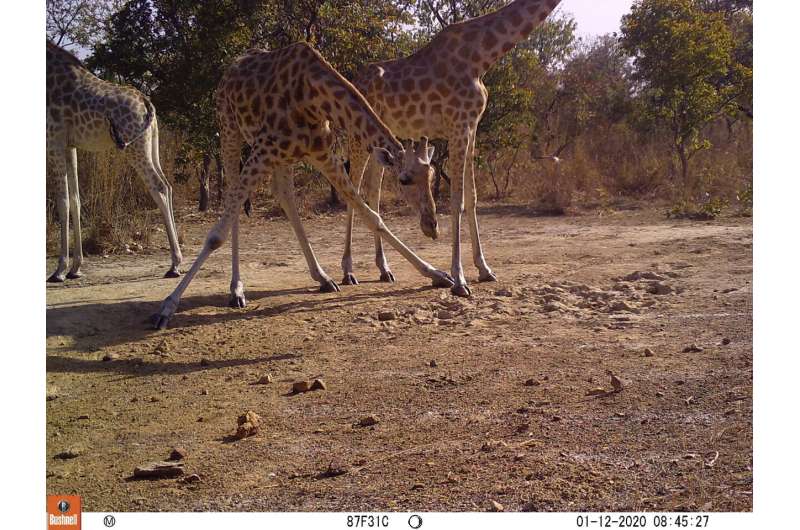This article has been reviewed according to Science X's editorial process and policies. Editors have highlighted the following attributes while ensuring the content's credibility:
fact-checked
trusted source
proofread
Kordofan giraffes face local extinction if poaching continues, study suggests

Poaching of two Critically Endangered Kordofan giraffes per year could result in extinction in just 15 years within Cameroon's Bénoué National Park without intervention. These are the alarming new findings of a University of Bristol and Bristol Zoological Society-led study published in the African Journal of Ecology.
One of the last populations of Kordofan giraffes roam Cameroon's Bénoué National Park in Africa with current estimates indicating there are fewer than 50 individuals left in the park. Bristol Zoological Society have been working to conserve this highly-threatened mammal since 2017.
While poaching is frequently cited as a cause of population decline, evidence remains mostly anecdotal, with little research into its overall impact. Illegal hunters kill giraffes for their meat but also for their pelts, bones, hair and tails which are highly valued by some cultures.
Researchers from Bristol Vet School and Bristol Zoological Society sought to analyze the effectiveness of different conservation measure interventions using a population modeling technique. The team compared anti-poaching interventions, population supplementation, and habitat protection. Each intervention was simulated individually and in combination to investigate their relative impact on population viability.
Their modeling found the removal of one male and one female giraffe every year would result in an average time to extinction of just 15.3 years. The poaching of female giraffes had a more significant impact on population viability than males. The research is published in the African Journal of Ecology.
The team's findings confirm that conservation management should prioritize strengthening existing anti-poaching activity in conjunction with protecting wildlife corridors to aid dispersal.
Kane Colston, the study's lead author, who undertook the study as part of his Master's degree at Bristol Vet School in conjunction with teaching partners Bristol Zoological Society, said, "Our findings confirm anti-poaching measures appear the most significant for population viability. The extent of poaching in Bénoué National Park is still unclear as far higher giraffe poaching rates have been reported in other national parks, but recent confirmed reports of the poaching of two giraffe in a period of just three months highlight the urgency of conservation intervention."
Dr. Sam Penny, the project lead from Bristol Zoological Society, added, "These findings really underscore the magnitude of the threat facing Bénoué National Park's Kordofan giraffe and highlight the importance of our conservation work in the area. We will continue to work with the park's Conservation Service and our partner NGO Sekakoh to ensure anti-poaching initiatives are prioritized within the landscape."
More information: Kane P. J. Colston et al, Viability analysis of Kordofan giraffe (Giraffa camelopardalis antiquorum) in a protected area in Cameroon, African Journal of Ecology (2023). DOI: 10.1111/aje.13196
Provided by University of Bristol


















